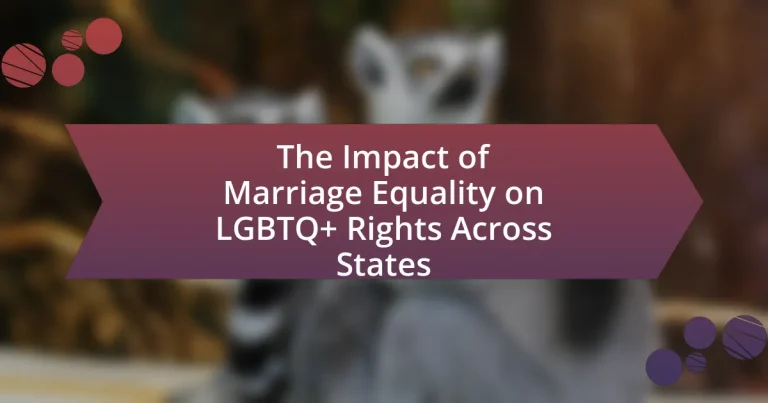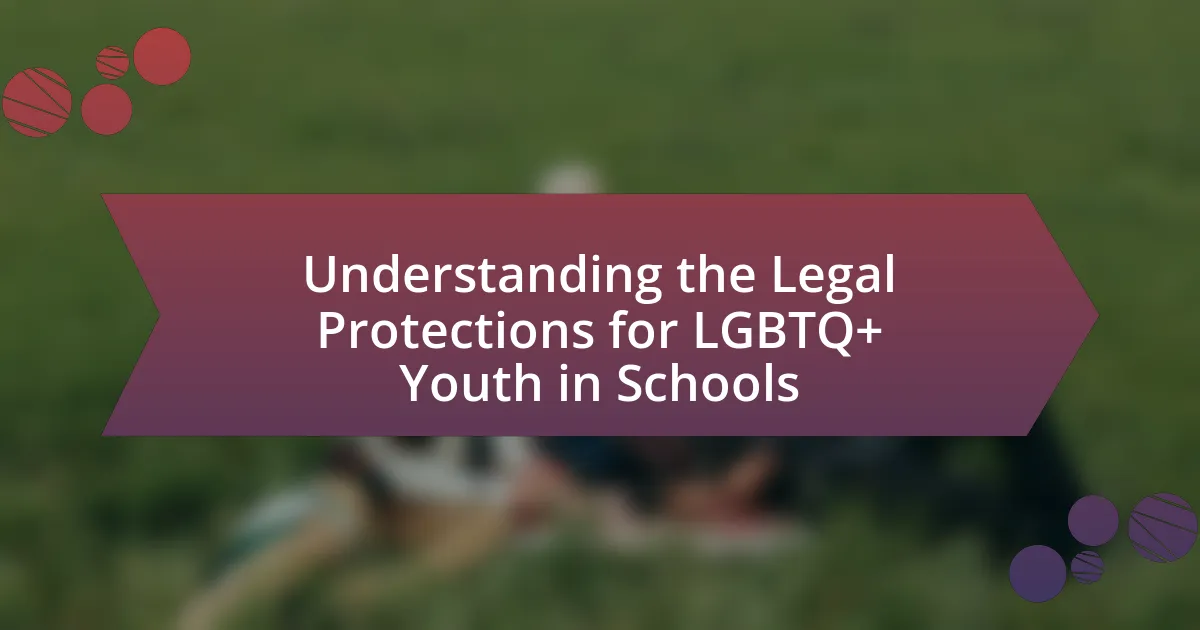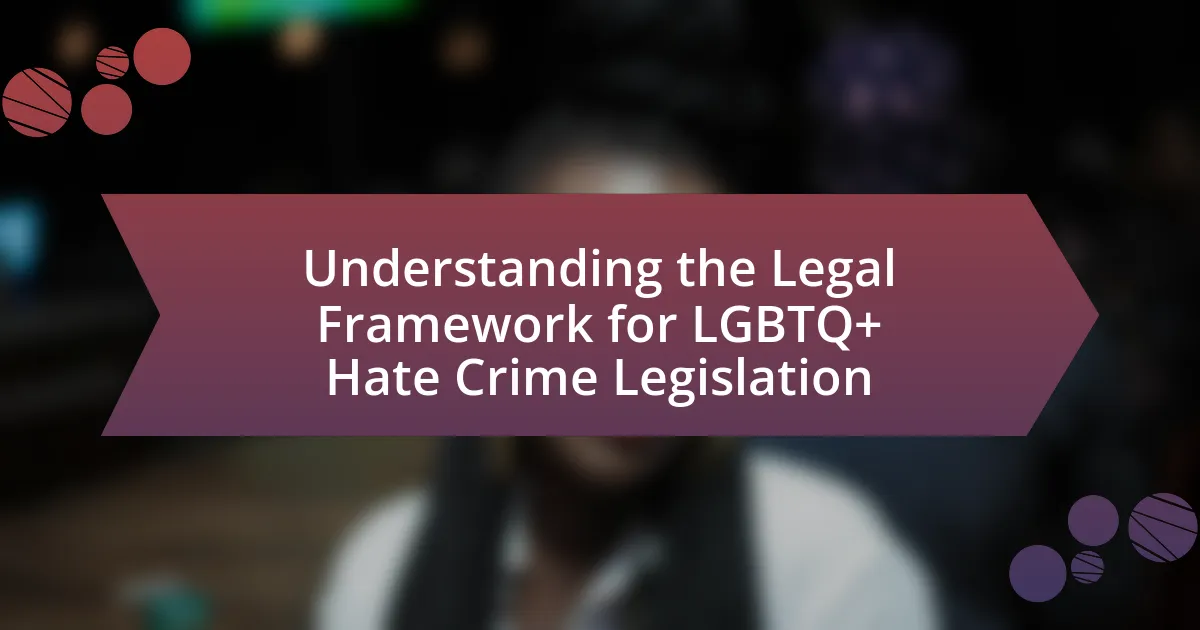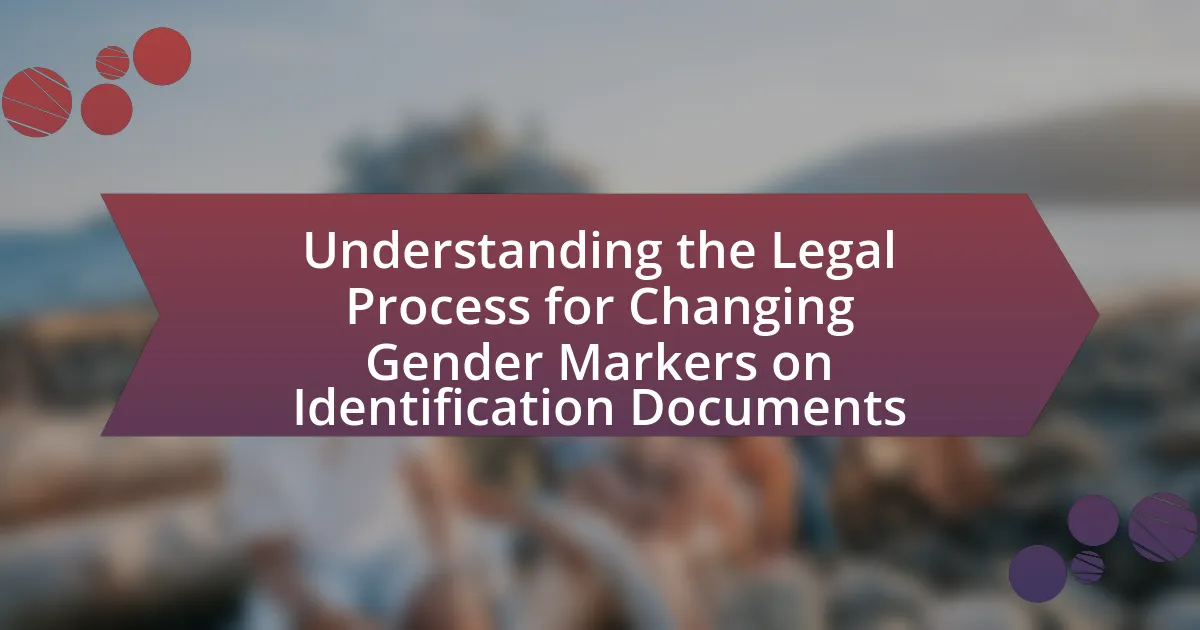Marriage equality has profoundly influenced LGBTQ+ rights across the United States by providing legal recognition and protections for same-sex couples. Following the landmark Supreme Court decision in Obergefell v. Hodges in 2015, which legalized same-sex marriage nationwide, there has been a notable decrease in discrimination against LGBTQ+ individuals and improved mental health outcomes within these communities. The article explores the evolution of marriage equality, key milestones in its journey, varying state responses, and the ongoing challenges faced by LGBTQ+ individuals post-marriage equality. It also examines the social implications, legal protections, and financial benefits that have emerged as a result of marriage equality, highlighting the critical role of advocacy groups in promoting continued progress for LGBTQ+ rights.

What is the Impact of Marriage Equality on LGBTQ+ Rights Across States?
Marriage equality has significantly advanced LGBTQ+ rights across states by providing legal recognition and protections for same-sex couples. This legal recognition has led to increased visibility and acceptance of LGBTQ+ individuals, fostering a more inclusive societal environment. For instance, following the Supreme Court’s decision in Obergefell v. Hodges in 2015, which legalized same-sex marriage nationwide, states have seen a marked decrease in discrimination against LGBTQ+ individuals, as marriage equality has been linked to broader civil rights protections. Studies, such as those conducted by the Williams Institute, indicate that states with marriage equality experience lower rates of mental health issues among LGBTQ+ populations, highlighting the positive impact of legal recognition on overall well-being.
How has marriage equality evolved in the United States?
Marriage equality in the United States has evolved significantly, culminating in the Supreme Court’s 2015 decision in Obergefell v. Hodges, which legalized same-sex marriage nationwide. Prior to this landmark ruling, marriage equality was achieved in various states through legislative action and court rulings, starting with Massachusetts in 2004, which became the first state to allow same-sex marriage. By 2015, 36 states and the District of Columbia had legalized same-sex marriage, reflecting a growing acceptance and support for LGBTQ+ rights across the country. The Obergefell decision established that same-sex couples have the constitutional right to marry, reinforcing the principle of equal protection under the law. This evolution has had a profound impact on LGBTQ+ rights, fostering greater visibility and acceptance while also prompting ongoing discussions about related issues such as discrimination and family rights.
What key milestones have marked the journey towards marriage equality?
Key milestones in the journey towards marriage equality include the 2003 U.S. Supreme Court decision in Lawrence v. Texas, which struck down sodomy laws and laid the groundwork for future LGBTQ+ rights. In 2015, the landmark Supreme Court case Obergefell v. Hodges legalized same-sex marriage nationwide, affirming that the right to marry is a fundamental liberty protected by the Constitution. Additionally, the repeal of the Defense of Marriage Act in 2013 allowed federal recognition of same-sex marriages, further advancing equality. These milestones collectively represent significant legal and societal shifts towards marriage equality in the United States.
How have different states responded to marriage equality legislation?
Different states have responded to marriage equality legislation with a range of actions, including legalization, resistance, and the implementation of protective measures for LGBTQ+ rights. For instance, states like Massachusetts and California were early adopters, legalizing same-sex marriage in 2004 and 2008, respectively, setting precedents for other states. Conversely, states such as Texas and Alabama have enacted laws to limit marriage equality, including constitutional amendments that define marriage as between one man and one woman. Additionally, some states have introduced legislation to protect LGBTQ+ rights in response to marriage equality, such as anti-discrimination laws in states like New York and Illinois. These varied responses illustrate the complex landscape of marriage equality across the United States, reflecting differing cultural, political, and social attitudes toward LGBTQ+ rights.
Why is marriage equality significant for LGBTQ+ rights?
Marriage equality is significant for LGBTQ+ rights because it legally recognizes same-sex relationships, providing equal rights and protections under the law. This recognition helps dismantle systemic discrimination, as evidenced by the 2015 U.S. Supreme Court ruling in Obergefell v. Hodges, which affirmed that same-sex couples have the constitutional right to marry. The ruling not only granted legal recognition but also facilitated access to benefits such as healthcare, tax advantages, and inheritance rights, which were previously denied to same-sex couples. Furthermore, marriage equality fosters societal acceptance and reduces stigma, contributing to improved mental health outcomes within the LGBTQ+ community.
What are the social implications of marriage equality for LGBTQ+ individuals?
Marriage equality significantly enhances the social standing and rights of LGBTQ+ individuals by providing legal recognition and protection of their relationships. This recognition fosters greater acceptance within society, as it normalizes same-sex partnerships and challenges discriminatory attitudes. Studies, such as those conducted by the Williams Institute, indicate that marriage equality correlates with improved mental health outcomes for LGBTQ+ individuals, reducing rates of depression and anxiety. Furthermore, legal marriage allows LGBTQ+ couples access to essential benefits, such as healthcare and inheritance rights, which were previously denied. This shift not only affirms their identities but also promotes social cohesion and equality, contributing to a more inclusive society.
How does marriage equality influence legal protections for LGBTQ+ rights?
Marriage equality significantly enhances legal protections for LGBTQ+ rights by establishing a legal framework that recognizes same-sex relationships as equal to heterosexual marriages. This recognition leads to broader anti-discrimination laws and policies, as seen in various jurisdictions where the legalization of same-sex marriage has prompted legislative changes to protect LGBTQ+ individuals from discrimination in employment, housing, and public accommodations. For instance, after the U.S. Supreme Court’s decision in Obergefell v. Hodges in 2015, which legalized same-sex marriage nationwide, many states expanded their civil rights protections to include sexual orientation and gender identity, thereby reinforcing the legal standing of LGBTQ+ individuals.
What challenges remain for LGBTQ+ rights post-marriage equality?
Post-marriage equality, significant challenges remain for LGBTQ+ rights, including discrimination in employment, housing, and healthcare. Despite legal recognition of same-sex marriage, many states lack comprehensive anti-discrimination laws that protect LGBTQ+ individuals. For instance, a 2021 report by the Williams Institute found that 29 states do not have laws prohibiting employment discrimination based on sexual orientation or gender identity. Additionally, LGBTQ+ youth face higher rates of bullying and mental health issues, with the Trevor Project’s 2021 National Survey on LGBTQ Youth Mental Health indicating that 42% of LGBTQ+ youth seriously considered suicide in the past year. These ongoing issues highlight the need for further legal protections and societal acceptance to ensure full equality for LGBTQ+ individuals.
What ongoing discrimination do LGBTQ+ individuals face in various states?
LGBTQ+ individuals face ongoing discrimination in various states through legal and social barriers that affect their rights and well-being. For instance, in many states, there are no comprehensive non-discrimination laws protecting LGBTQ+ individuals in employment, housing, and public accommodations, leading to systemic inequalities. According to the Human Rights Campaign’s 2021 report, 29 states lack explicit protections against discrimination based on sexual orientation and gender identity. Additionally, some states have enacted laws that restrict the rights of transgender individuals, such as prohibiting access to gender-affirming healthcare or participation in sports consistent with their gender identity. These discriminatory practices contribute to higher rates of mental health issues and violence against LGBTQ+ individuals, highlighting the urgent need for legal reforms to ensure equality and protection across all states.
How do state laws vary in protecting LGBTQ+ rights beyond marriage?
State laws vary significantly in protecting LGBTQ+ rights beyond marriage, with some states enacting comprehensive anti-discrimination laws while others lack such protections. For instance, states like California and New York have robust laws that prohibit discrimination based on sexual orientation and gender identity in employment, housing, and public accommodations. In contrast, states such as Alabama and Mississippi have limited or no legal protections for LGBTQ+ individuals, allowing for discrimination in various sectors. According to the Human Rights Campaign’s 2021 report, only 22 states and the District of Columbia have laws that explicitly protect against discrimination based on sexual orientation and gender identity, highlighting the disparity in legal protections across the country.
How does marriage equality affect LGBTQ+ communities differently across states?
Marriage equality affects LGBTQ+ communities differently across states due to varying legal protections, social acceptance, and access to resources. In states where marriage equality is recognized, LGBTQ+ individuals often experience greater legal rights, such as inheritance and healthcare decision-making, which are not uniformly available in states lacking such recognition. For instance, a 2020 study by the Williams Institute found that states with marriage equality reported lower rates of mental health issues among LGBTQ+ individuals, highlighting the positive impact of legal recognition on community well-being. Conversely, in states where marriage equality is not recognized, LGBTQ+ individuals may face discrimination and limited access to supportive services, leading to increased vulnerability and marginalization. This disparity underscores the importance of state-level policies in shaping the lived experiences of LGBTQ+ communities across the United States.
What role do advocacy groups play in promoting LGBTQ+ rights after marriage equality?
Advocacy groups play a crucial role in promoting LGBTQ+ rights after marriage equality by continuing to address issues such as discrimination, healthcare access, and social acceptance. These organizations, like the Human Rights Campaign and GLAAD, actively campaign for comprehensive anti-discrimination laws and policies that protect LGBTQ+ individuals in various aspects of life, including employment and housing. For instance, the Equality Act, which aims to extend civil rights protections to LGBTQ+ individuals, has been a focal point for advocacy groups, highlighting the ongoing need for legal protections beyond marriage. Additionally, advocacy groups provide resources, education, and support to LGBTQ+ communities, fostering awareness and acceptance while combating stigma and misinformation. Their efforts are essential in ensuring that the gains made through marriage equality are not only preserved but expanded to encompass broader civil rights for all LGBTQ+ individuals.
What specific rights have been enhanced due to marriage equality?
Marriage equality has enhanced specific rights such as the legal recognition of same-sex marriages, which grants couples access to spousal benefits, tax advantages, and inheritance rights. This legal recognition ensures that same-sex couples can make medical decisions for their partners, access family health insurance plans, and receive social security benefits. According to the U.S. Supreme Court ruling in Obergefell v. Hodges (2015), the right to marry is a fundamental right protected by the Constitution, affirming that same-sex couples are entitled to the same legal protections and benefits as heterosexual couples.
How has marriage equality impacted healthcare access for LGBTQ+ individuals?
Marriage equality has significantly improved healthcare access for LGBTQ+ individuals by allowing them to obtain spousal benefits and coverage under family health plans. Prior to the legalization of same-sex marriage, many LGBTQ+ individuals faced barriers in accessing healthcare due to lack of recognition of their relationships, which often excluded them from family insurance plans. According to a study published in the American Journal of Public Health, states that legalized same-sex marriage saw a 7% increase in health insurance coverage among LGBTQ+ individuals, highlighting the direct correlation between marriage equality and improved healthcare access. This legal recognition has also facilitated better mental health outcomes, as individuals in legally recognized relationships report lower levels of stress and anxiety related to healthcare access.
What financial benefits have emerged from marriage equality for LGBTQ+ couples?
Marriage equality has provided significant financial benefits for LGBTQ+ couples, including access to tax advantages, health insurance benefits, and inheritance rights. For instance, married couples can file joint tax returns, which often results in lower tax liabilities due to the marriage bonus. Additionally, LGBTQ+ couples can now access spousal health insurance plans, which can lead to substantial savings on medical expenses. Furthermore, marriage grants automatic inheritance rights, allowing partners to inherit assets without incurring estate taxes, which can be a considerable financial advantage. According to a 2015 study by the Williams Institute, marriage equality has contributed to an estimated $1.5 billion in economic benefits to the U.S. economy, highlighting the broader financial impact of these legal changes.
What are the best practices for supporting LGBTQ+ rights in the context of marriage equality?
The best practices for supporting LGBTQ+ rights in the context of marriage equality include advocating for inclusive legislation, providing education on LGBTQ+ issues, and fostering community support networks. Advocating for inclusive legislation ensures that laws protect the rights of LGBTQ+ individuals, as seen in the legalization of same-sex marriage in the U.S. through the Supreme Court’s decision in Obergefell v. Hodges in 2015, which affirmed marriage equality as a constitutional right. Providing education on LGBTQ+ issues helps to combat discrimination and misinformation, promoting understanding and acceptance within society. Additionally, fostering community support networks, such as LGBTQ+ organizations and allies, creates safe spaces for individuals to share experiences and access resources, thereby strengthening the overall movement for equality.





